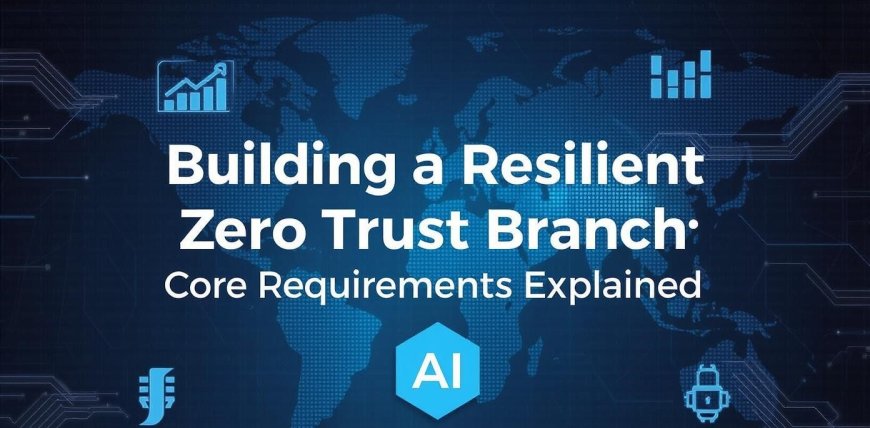Building a Resilient Zero Trust Branch: Core Requirements Explained
As cyberattacks become more sophisticated and remote work continues to proliferate, businesses must modernize their approach to securing enterprise networks. Traditional perimeter-based security models are no longer sufficient. Instead, Zero Trust architecture is emerging as the new gold standard for safeguarding users, data, and applications—especially at the branch level. Implementing a Zero Trust model across distributed environments requires rethinking how organizations control access, verify trust, and ensure visibility.

As cyberattacks become more sophisticated and remote work continues to proliferate, businesses must modernize their approach to securing enterprise networks. Traditional perimeter-based security models are no longer sufficient. Instead, Zero Trust architecture is emerging as the new gold standard for safeguarding users, data, and applicationsespecially at the branch level. Implementing a Zero Trust model across distributed environments requires rethinking how organizations control access, verify trust, and ensure visibility.
For enterprises expanding their branch offices or supporting remote teams, understanding the 4 requirements for aZero Trust Branchis essential. These pillars include identity and access control, micro-segmentation, secure connectivity, and continuous monitoring. By embedding these components into branch infrastructure, organizations can strengthen security without compromising agility or performance.
Identity and Access Control: The First Line of Defense
The foundation of a Zero Trust branch begins with strict identity and access control. Unlike legacy models that trust users or devices inside the network perimeter, Zero Trust assumes breach and continuously verifies every access request.
In a Zero Trust branch, all userswhether internal employees, contractors, or third partiesmust be authenticated and authorized before gaining access to systems or data. This is achieved using robust identity and access management (IAM) solutions. Features such as multifactor authentication (MFA), single sign-on (SSO), and context-based access decisions are vital.
Policies must also adapt to real-time signals. This includes evaluating user location, device posture, time of day, and historical behavior. Conditional access ensures users only access what they need, when they need it.
Device trust is equally important. Each device should be verified and monitored before being allowed to communicate with branch resources. Zero Trust Network Access (ZTNA) replaces traditional VPNs, providing secure, granular access to applications without exposing the broader network.
A modern Zero Trust branch demands that identity becomes the new perimeterand every access decision is risk-informed and enforceable.
Micro-Segmentation for Limiting Lateral Movement
The second critical requirement in understanding the 4 requirements for a Zero Trust branch is micro-segmentation. Instead of flat networks where once inside, an attacker can move freely, Zero Trust branches enforce tight segmentation between users, devices, and applications.
Micro-segmentation breaks the network into distinct security zones. Access between zones is governed by strict policies. For example, a user in the HR department cannot access finance servers, and a printer cannot communicate with endpoint devices unless explicitly allowed.
Network segmentation can occur at multiple layersapplication, user, workload, and even process level. Technologies like software-defined networking (SDN) and next-generation firewalls enable fine-grained segmentation at the branch level without requiring complex hardware deployments.
Micro-segmentation ensures that if a breach occurs, it is contained quickly, and the blast radius is minimized. Attackers are unable to move laterally across the network, thereby protecting sensitive data and mission-critical systems.
Adopting micro-segmentation at the branch is not just a best practiceit is a foundational principle in enforcing Zero Trust policies where agility and remote operations are prioritized.
Secure Connectivity: Replacing Legacy Architectures
Traditional hub-and-spoke architectures were designed for a time when most applications were hosted in corporate data centers. In contrast, today's enterprises are embracing cloud, SaaS, and edge computing. Therefore, secure connectivity is a vital component in the 4 requirements for a Zero Trust branch.
To implement Zero Trust across branch environments, organizations must replace traditional VPNs and MPLS lines with modern software-defined approaches. This is where technologies such as Secure Access Service Edge (SASE) and SD-WAN play a pivotal role.
SASE combines network and security functions into a unified cloud-native service. It provides identity-aware access, integrated threat protection, and optimized connectivity across all locations. SD-WAN complements SASE by intelligently routing traffic based on application type, user identity, and network conditions.
Zero Trust principles are embedded into these architectures. No trafficregardless of originis trusted by default. All branch communications, whether internal or internet-bound, are encrypted and subject to continuous inspection.
Moreover, secure connectivity must extend to remote workers, IoT devices, and third-party vendors. Implementing a consistent security posture across users, locations, and applications ensures that Zero Trust becomes operational at every branch node.
Continuous Monitoring and Analytics for Threat Detection
The final element among the 4 requirements for a Zero Trust branch is continuous monitoring. Unlike traditional security that relies on point-in-time assessments, Zero Trust assumes that compromise can happen at any time.
At the branch level, organizations need full visibility into all user activities, device interactions, network traffic, and application behavior. Advanced analytics tools powered by AI and machine learning can identify anomalies in real timeflagging risky behaviors such as privilege escalation, unauthorized access attempts, or unusual data transfers.
Security Information and Event Management (SIEM) platforms and Extended Detection and Response (XDR) solutions help centralize logs and correlate events across branches, endpoints, and cloud assets. These insights are essential to detect and respond to threats quickly before they spread or cause damage.
Moreover, security teams must adopt a proactive stance with threat hunting capabilities. Automation and orchestration streamline incident response, while behavior-based policies evolve to counter emerging threats.
By embedding real-time monitoring and adaptive defense, Zero Trust branches move from reactive to predictive security modelsclosing the loop on trust evaluation, enforcement, and response.
Why the Zero Trust Branch Matters More Than Ever
Todays businesses are decentralized. Branches host critical applications, support remote employees, and serve as direct links to customers and partners. The traditional approach of routing all traffic through a central data center creates bottlenecks, increases latency, and exposes the enterprise to unnecessary risk.
By embracing the 4 requirements for a Zero Trust branchidentity-based access, micro-segmentation, secure connectivity, and continuous monitoringenterprises create a scalable, cloud-friendly architecture that adapts to changing needs.
Zero Trust is not a single product or switch. It is a strategic framework requiring coordination between networking, security, and IT operations. Implementing these requirements at the branch level ensures that security does not get in the way of innovationit powers it.
Read Full Article : https://businessinfopro.com/4-requirements-for-a-zero-trust-branch/
About Us: Businessinfopro is a trusted platform delivering insightful, up-to-date content on business innovation, digital transformation, and enterprise technology trends. We empower decision-makers, professionals, and industry leaders with expertly curated articles, strategic analyses, and real-world success stories across sectors. From marketing and operations to AI, cloud, and automation, our mission is to decode complexity and spotlight opportunities driving modern business growth. At Businessinfopro, we go beyond newswe provide perspective, helping businesses stay agile, informed, and competitive in a rapidly evolving digital landscape. Whether you're a startup or a Fortune 500 company, our insights are designed to fuel smarter strategies and meaningful outcomes.
































